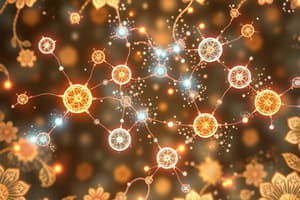Podcast
Questions and Answers
What bond transfers electrons from cation (metal) to anion (non-metal)?
What bond transfers electrons from cation (metal) to anion (non-metal)?
- covalent
- ionic (correct)
- metallic
what bond share electrons between two non-metals?
what bond share electrons between two non-metals?
- covalent (correct)
- metallic
- ionic
what bond delocalizes (electrons everywhere) (create electron sea)?
what bond delocalizes (electrons everywhere) (create electron sea)?
- covalent
- metallic (correct)
- ionic
what does malleable mean?
what does malleable mean?
what does lustrous mean?
what does lustrous mean?
what does ductile mean?
what does ductile mean?
what does alloy mean?
what does alloy mean?
what type of bond DOES NOT conduct electricity?
what type of bond DOES NOT conduct electricity?
what type of bonds share equal electrons?
what type of bonds share equal electrons?
what type of bond has unequal sharing of electrons?
what type of bond has unequal sharing of electrons?
Flashcards are hidden until you start studying
Study Notes
Chemical Bonding
- Ionic bonds transfer electrons from a cation (metal) to an anion (non-metal).
- Covalent bonds share electrons between two non-metals.
- Metallic bonds delocalize electrons, creating a "sea" of electrons.
Properties of Metals
- Malleable means capable of being shaped or molded into different forms.
- Lustrous means having a shiny or reflective appearance.
- Ductile means capable of being stretched or drawn into thin wires.
Bonding Characteristics
- Ionic bonds do not conduct electricity.
- Covalent bonds share electrons equally.
- Polar covalent bonds have unequal sharing of electrons.
Alloys
- An alloy is a mixture of two or more elements, at least one of which is a metal.
Studying That Suits You
Use AI to generate personalized quizzes and flashcards to suit your learning preferences.



